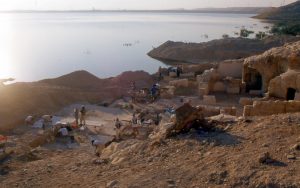Reburial of the excavation
All the trenches were reburied at the end of the excavation according to a strategy based on time limits (overall calendar, availability of machinery and materials) and site logistics (accessibility, topography, location of trenches). The techniques and materials used for reburial were chosen on the basis of availability of materials in the region, conservation requirements for the structures left in situ and the topographic characteristics of the trenches.
In general, all the structures were buried with a double layer of materials: the first, composed of earth and sand, was about 50 cm thick; it was followed by a layer of gravel and pebbles varying according to the slope involved.
The earth and sand mixture applied in direct contact with the structures was dampened and compacted to prevent shrinkage during flooding. Special attention was paid to filling cisterns, covered rooms and irregularities of the ground to prevent collapses that could damage floors and pavements. These operations were done by hand with wheelbarrows and shovels. The rest of the reburial work was done with mechanical means where possible.
A total of 8700 m2 was reburied, divided into 19 excavation areas. The volume of materials used in reburial was 10,500 m3, equal to 630 truckloads of sand, gravel and pebbles.
At the end of the excavation, the conservators focused their attention on the so-called “fluctuation band” (a strip three meters high) because the action of water continuously changing level immediately showed its destructive potential.
Burlap bags filled with sand, gravel and cement were placed to form containment barriers and covered with a large amount of inert material (sand and gravel).
These measures were a temporary emergency solution while waiting for a general program to protect and maintain the site to be defined. They were found to be efficient for a significant portion of the coastline, but were insufficient in places heavily exposed to wind and waves.





















